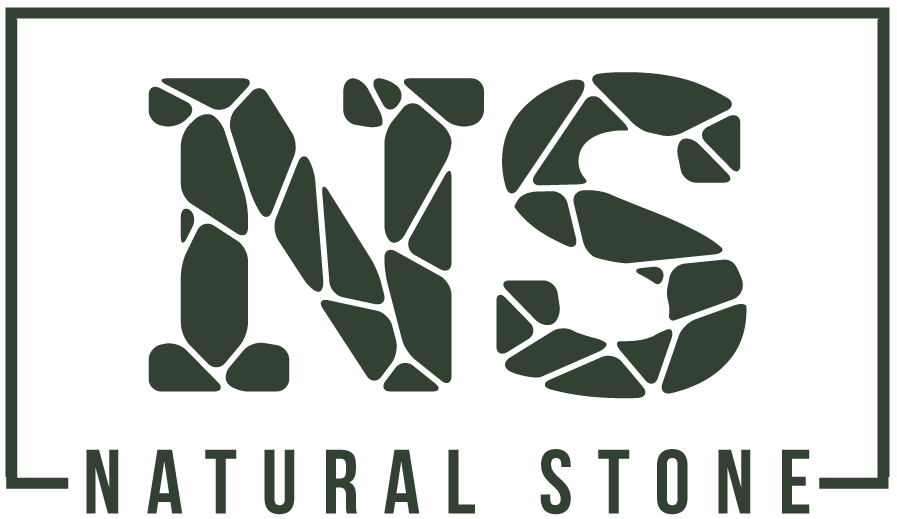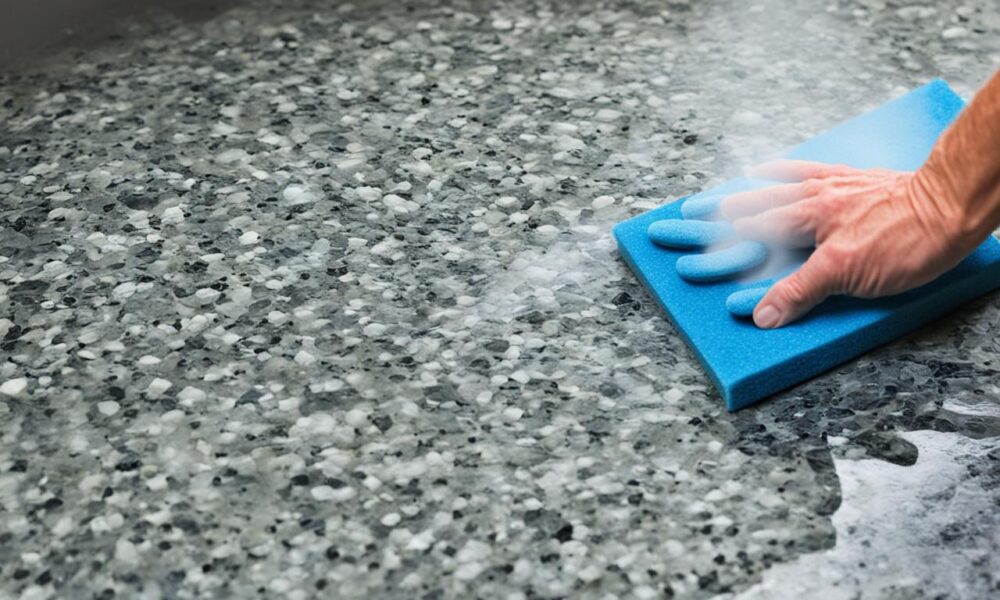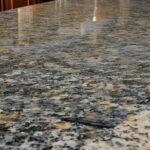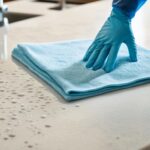Removing Stains from Natural Stone: A Complete Guide
Natural stone surfaces like marble, granite, limestone, and travertine are known for their beauty and strength. They bring elegance to any room. But, they can get stained. It’s important to clean up spills fast to avoid permanent damage. Removing stone stains might seem hard, but you can do it with the right methods.
To start removing a stain, figure out what kind it is. Common stains include organic stuff, oils, ink, metals, and biological stuff. Each stain needs a special way to clean it. This guide will show you how to clean natural stone, from spotting stains to getting rid of them. It covers cleaning marble, granite, limestone, travertine, slate, and quartzite.
Key Takeaways
- Act fast when you spill on natural stone surfaces
- Knowing the stain type helps pick the right cleaning method
- Poultices are great for removing tough stains
- Each stain type needs its own cleaning solution and method
- Good care and maintenance can prevent stains and keep natural stone looking great
Understanding the Basics of Natural Stone
Natural stone is a top pick for countertops and flooring because it’s tough, beautiful, and unique. To keep your natural stone looking great, it’s key to know the different types and their traits.
Types of Natural Stone
Many types of natural stone are used in homes, each with its own look and feel:
- Marble: This stone is famous for its elegant veining and rich look. It’s made mostly of calcite or dolomite. Marble is softer and more prone to stains and etching.
- Granite: Granite comes from molten magma and is very hard and durable. It’s great for busy areas and kitchen counters because it resists scratches, chips, and stains well.
- Limestone: Limestone is mainly calcium carbonate and has a soft, earthy look. It needs sealing often because it’s soft and absorbs liquids easily.
- Travertine: Travertine forms from mineral deposits in hot springs or caves. It has a unique, pitted surface and is often used for flooring and wall cladding.
- Slate: Slate is a metamorphic rock with a layered look. It’s known for its dark colors and natural texture. It’s durable and great for both inside and outside use.
- Quartzite: Quartzite is made from sandstone and is very hard. It looks like marble but is even harder and more resistant to scratches and stains.
Characteristics of Natural Stone
Natural stone falls into three main categories: sedimentary, metamorphic, and igneous. Each type has its own traits that affect its durability, look, and resistance to stains.
| Geological Classification | Composition | Characteristics |
|---|---|---|
| Sedimentary | Formed from deposited sediments, such as sand, silt, or organic matter | Relatively soft and porous, prone to staining and etching |
| Metamorphic | Formed through the transformation of existing rock under heat and pressure | Varied hardness and porosity, depending on the specific stone type |
| Igneous | Formed from cooled magma or lava | Generally hard, dense, and resistant to staining and scratching |
Natural stones can also be calcareous or siliceous, based on what they’re made of. Calcareous stones like marble and limestone are mostly calcium carbonate and react to acidic things. Siliceous stones, such as granite and quartzite, are mostly silicates and don’t react much to kitchen acids.
Knowing what your natural stone is like is key to taking good care of it. This helps keep it looking great for a long time.
Identifying Different Types of Stains
Keeping natural stone surfaces looking great means knowing about different stains. Each stain type needs a special way to remove it without harming the stone. We’ll look at the five main kinds of stains that can affect natural stone.
Oil-Based Stains
Oil-based stains come from things like cooking oil, grease, makeup, and tar. They make the stone look darker and are hard to get rid of. To remove these stains, you need a cleaner that breaks down the oil.
Organic Stains
Organic stains happen from everyday items like coffee, tea, fruit, and tobacco. They look pinkish-brown on the stone. It’s important to clean these stains quickly because they can go deep into the stone.
Metal-Based Stains
Metal-based stains come from touching the stone with iron, rust, copper, or bronze. They look orange, brown, or green and are hard to remove. When cleaning these stains, be careful not to make things worse.
| Metal | Stain Color |
|---|---|
| Iron/Rust | Orange or Brown |
| Copper | Green or Blue-Green |
| Bronze | Green or Muddy Brown |
Biological Stains
Biological stains come from algae, mildew, or fungi on the stone. They look bad and can harm the stone if not cleaned quickly. You can use diluted ammonia, bleach, or hydrogen peroxide to clean these stains, depending on the stone type.
Ink Stains
Ink stains are hard to remove from natural stone. The right cleaner depends on the stone’s color and makeup. You might use bleach, hydrogen peroxide, lacquer thinner, or acetone. Always test the cleaner first on a small, hidden spot.
Act fast and use the right cleaning methods for any stain on natural stone. This helps prevent damage and gets the best results.
Knowing about these five main stain types helps you keep your natural stone looking great.
Preparing to Remove Stains
Before you start removing stains, make sure you’re ready. This means getting the right materials and following safety steps. This way, you’ll remove stains safely and effectively.
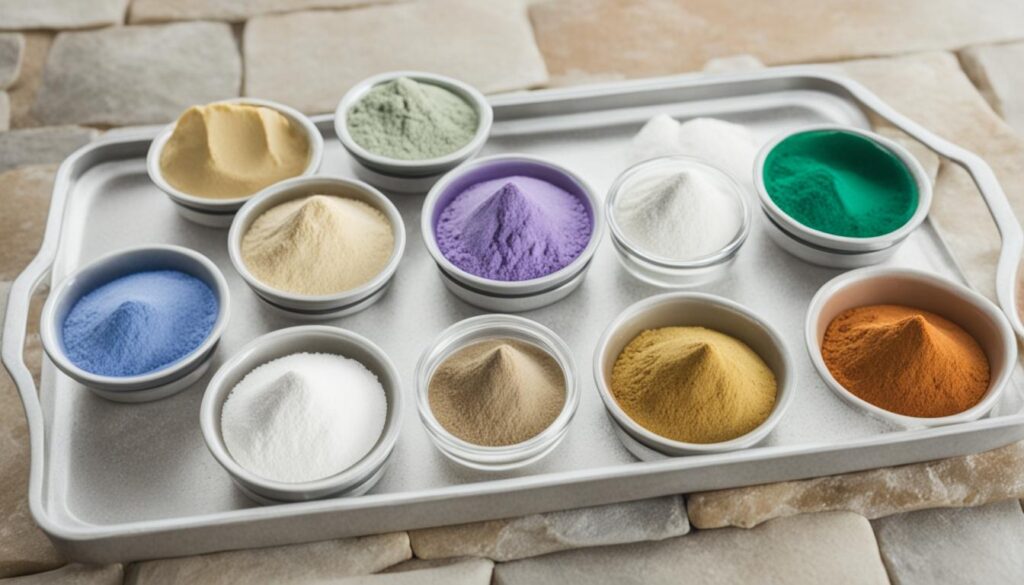
Gathering Necessary Materials
To clean stains from your natural stone, you’ll need certain poultice materials and cleaners. Here are some key items:
- Poultice powders (e.g., diatomaceous earth, baking soda, talc)
- Cleaning agents (e.g., hydrogen peroxide, ammonia, acetone)
- Plastic wrap
- Tape
- Protective gloves
The materials you need can change based on the stain type. For example, oil-based stains need different poultices than organic ones. Always check with a pro or a trusted source like the Natural Stone Institute for the right materials for your stain.
Safety Precautions
Handling cleaning agents and poultices safely is key. Many can be dangerous if not used right. Here are some safety tips:
- Always wear protective gloves with chemicals like hydrogen peroxide, ammonia, or acetone.
- Work in a place with good airflow to avoid breathing in fumes from cleaners.
- Don’t mix ammonia and bleach, as it makes a harmful gas.
- Keep all cleaners and poultices away from kids and pets.
- Always read and follow the directions on any cleaning products or safety gear.
With the right materials and safety steps, you’re set to remove stains from your natural stone. Remember, success comes from using the right tools, methods, and caution.
How to Remove Stains from Natural Stone: A Comprehensive Guide
To remove stains from natural stone, start by blotting the spill with a clean cloth or paper towel. This action stops the stain from going deeper into the stone. Then, rinse the area with water to weaken the stain and reduce its effect.
Next, figure out what kind of stain you have. You might face oil-based, organic, metal-based, biological, or ink stains. Each type needs a different cleaning method. Pick a cleaner safe for natural stone and test it on a small area first.
Sometimes, you’ll need to use a poultice to get rid of tough stains. A poultice is a paste that draws out the stain from the stone. Here’s how to apply it:
- Mix the poultice material with the right cleaner to make a paste.
- Put a thick layer of the poultice over the stain, a bit beyond it.
- Wrap the poultice with plastic and tape it to keep it moist.
- Let it sit for 24-48 hours.
- Wash the area with water after removing the poultice.
- If the stain is still there, repeat the process until it’s gone.
Preventing stains is key to keeping your natural stone looking great. Clean and seal your stone often to reduce staining and make cleaning easier.
| Stain Type | Recommended Cleaning Agent | Poultice Material |
|---|---|---|
| Oil-based | Acetone, mineral spirits, or ammonia | Baking soda, talc, or diatomaceous earth |
| Organic | Hydrogen peroxide (12%) or bleach | Baking soda, talc, or diatomaceous earth |
| Metal-based | Commercial rust remover or poultice | Baking soda, talc, or diatomaceous earth |
| Biological | Hydrogen peroxide (12%) or bleach | Baking soda, talc, or diatomaceous earth |
| Ink | Acetone, mineral spirits, or bleach | Baking soda, talc, or diatomaceous earth |
By following this guide and using the right cleaners and poultices, you can remove stains from your natural stone. This keeps your stone looking beautiful for many years.
Using Poultices for Stain Removal
Poultices are great for getting rid of tough stains on natural stone. They pull the stain out of the stone and into an absorbent material. This makes the stone clean and free of stains. When regular cleaning doesn’t work, poultices can make your stone look new again.
What is a Poultice?
A poultice is a paste made from a cleaning agent and an absorbent material. Common absorbents include:
- Diatomaceous earth
- Baking soda
- Talc
- Paper fibers
- Cotton fibers
- Clay (sepiolite or attapulgite)
The cleaning agent in the paste depends on the stain type. For example, some poultices use ammonium carbonate or EDTA for metal stains. Others use sodium hydroxide for grease and paint.
Choosing the Right Poultice Materials
Picking the right poultice materials is key for effective stain removal. Here are some tips:
| Stain Type | Cleaning Agent | Absorbent Material |
|---|---|---|
| Oil-based (grease, cooking oil, cosmetics) | Soft liquid cleansers, household detergents, ammonia, mineral spirits, acetone | Diatomaceous earth, baking soda, talc |
| Organic (coffee, tea, fruit) | 12% hydrogen peroxide, ammonia | Paper or cotton fibers |
| Metal-based (rust, copper, bronze) | Ammonium carbonate, EDTA | Clay (sepiolite or attapulgite) |
| Ink | Bleach, hydrogen peroxide (light-colored stone), lacquer thinner, acetone (dark-colored stone) | Paper or cotton fibers |
Preparing and Applying a Poultice
After picking your poultice materials, follow these steps:
- Mix the cleaning agent and absorbent until it’s like peanut butter.
- Put a 1/4 to 1/2-inch thick layer of the paste over the stain, a bit beyond the stain.
- Wrap the poultice with plastic and secure it to keep it moist.
- Let it dry for 24 to 48 hours. It will pull the stain into the absorbent material.
- Scrape off the dried poultice with a wooden or plastic scraper.
- Clean the area with water and dry it with a soft cloth.
- If needed, repeat the process until the stain is gone.
Using poultices can effectively remove deep stains from natural stone, especially from older countertops.
Learning about poultice application and choosing the right materials can help you clean your natural stone surfaces.
Removing Oil-Based Stains
Oil-based stains are common on natural stone, especially in kitchens and dining areas. These stains come from cooking oils, salad dressings, and other oily substances. They can be tough, but the right cleaners and techniques can remove them without harming the stone.
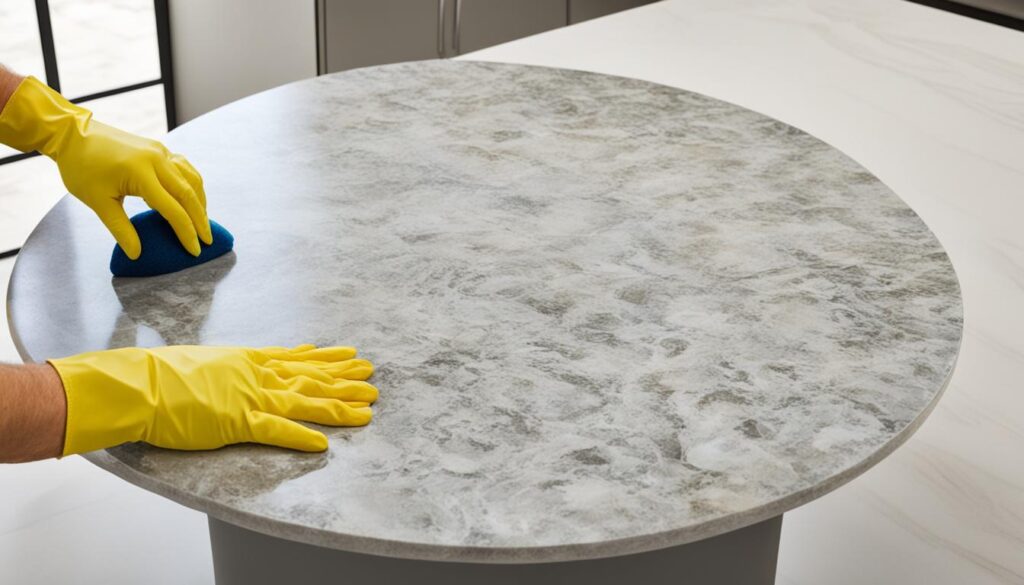
Recommended Cleaners and Poultices
For oil-based stains on natural stone, you need the right cleaners and poultices. Some good options are:
- Soft liquid cleansers
- Household detergents
- Mineral spirits
- Acetone
- Ammonia
- Bleach (for light-colored stones)
Always test any cleaner on a small, hidden spot first. This makes sure it won’t discolor or damage the stone.
Step-by-Step Guide
- Blot the stained area with a clean, white cloth or paper towel to remove oil. Don’t rub, as it can spread the stain deeper into the stone.
- Rinse the area with clean water and blot dry.
- Make a poultice by mixing your chosen cleaner (like mineral spirits or acetone) with an absorbent material like baking soda, flour, or talc. It should be a thick paste.
- Put the poultice on the stain, making sure it goes about an inch beyond the stain. The poultice should be 1/4 to 1/2 inch thick.
- Seal the poultice with plastic wrap and tape the edges. This keeps it from drying out too fast.
- Let the poultice sit for 24 to 48 hours.
- After the time is up, take off the plastic wrap and let the poultice dry completely. This might take a few hours.
- Once dry, scrape off the poultice with a plastic scraper or putty knife.
- Rinse the area with clean water and blot dry.
- If the stain is still there, repeat the process until it’s gone.
Preventing stains is key to keeping your natural stone looking great. Use coasters, placemats, and trivets to protect against oil-based stains. Clean spills right away to reduce staining risks.
Tackling Organic Stains
Organic stains from food, drinks, or mildew can happen on natural stone. These stains look like dark spots and can ruin your stone’s look if not cleaned. But, you can remove these stains with the right cleaners and methods.
Effective Cleaning Agents
Hydrogen peroxide and acetone are great for cleaning organic stains on natural stone. Hydrogen peroxide, at 12% strength, works well to remove stains. It breaks down and lifts the stain off the stone. Acetone dissolves and removes tough stains.
| Cleaning Agent | Strength | Stain Type |
|---|---|---|
| Hydrogen Peroxide | 12% (hair bleaching strength) | Organic stains |
| Acetone | 100% | Stubborn organic stains |
Poultice Application Process
To remove organic stains, use a poultice. A poultice is a paste you apply to the stain. It lets the cleaner go deep into the stone and pull out the stain. Here’s how to do it:
- Mix your chosen cleaner (hydrogen peroxide or acetone) with a poultice material like diatomaceous earth or talc. Make a thick paste.
- Put the poultice mix right on the stain, covering it fully.
- Wrap the poultice with plastic and tape it to keep it from drying out.
- Let the poultice work for 24 to 48 hours to pull out the stain.
- Take off the plastic and scrape off the poultice with a plastic scraper or a credit card.
- Wash the area with water to get rid of any leftover poultice.
- Check the stain. If it’s still there, do the poultice process again until it’s gone.
Experts say it’s important to clean organic stains right away. This stops them from going deeper into the stone and getting harder to remove. By acting fast and using the right cleaners and techniques, you can keep your stone looking great.
Dealing with Metal-Based Stains
Metal-based stains like iron, copper, and rust can be tough to get rid of on natural stone. They often need special techniques and products to remove without harming the stone.
To remove iron or rust stains, make a poultice with diatomaceous earth and a rust remover. Apply it to the stain and let it sit for a few hours. This lets the poultice pull out the stain from the stone. Always follow the rust remover’s instructions carefully.
Copper stains need a different method. Use a poultice with ammonia and a powdered absorbent. But be careful with ammonia as it can be dangerous. Make sure to work in a well-ventilated area and wear protective gear.
“Removing metal-based stains from natural stone can be a delicate process. It’s important to choose the right products and techniques to avoid causing further damage to the stone surface.” – Sarah Thompson, Stone Restoration Expert
Some stains are too hard to remove on your own. If you’re having trouble with iron, copper, or rust stains, get professional help. A skilled stone restoration expert can safely remove the stains and make your stone look new again.
For more info on stone restoration techniques and products, see this guide: Natural Stone Restoration Guide: Easy Steps.
| Stain Type | Poultice Material | Cleaning Agent |
|---|---|---|
| Iron/Rust Stains | Diatomaceous Earth | Commercial Rust Remover |
| Copper Stains | Powdered Absorbent Material | Ammonia |
When fighting metal-based stains on natural stone, be patient and keep at it. You might need to apply poultices and cleaners several times to get rid of the stain. But with the right approach and products, you can bring back your stone’s original beauty.
Addressing Biological Stains
Biological stains like algae, mildew, and fungi can be tough on natural stone surfaces. These stains not only make your stone look bad but can also cause more damage if ignored. Luckily, you can remove these stains and bring back your stone’s beauty with the right cleaning methods and products.
It’s crucial to act fast when dealing with biological stains to stop them from sinking deep into the stone. For surface stains, a simple cleaning solution might work. But for deeper stains, you might need a stronger approach. For expert tips on caring for your natural stone, check out the Natural Stone Care & Maintenance guide.
Surface-Level Stains
To clean surface-level stains, you can use diluted ammonia, bleach, or hydrogen peroxide. Be careful with these chemicals and wear protective gloves and eye gear. Put the solution on the stain and scrub it with a soft brush. Then, rinse it well with clean water and dry it with a soft cloth. Never mix ammonia and bleach because they create a dangerous gas.
Deep-Set Stains
For deep-set stains, you might need a stronger method like a poultice. Make a poultice by mixing your chosen cleaner with something like diatomaceous earth or paper towels. Put the poultice on the stain, cover it with plastic wrap, and let it sit for 24-48 hours. The poultice will pull the stain out of the stone.
After 24-48 hours, take off the poultice, rinse the area, and check how it looks. If the stain is still there, repeat the process until it’s gone.
